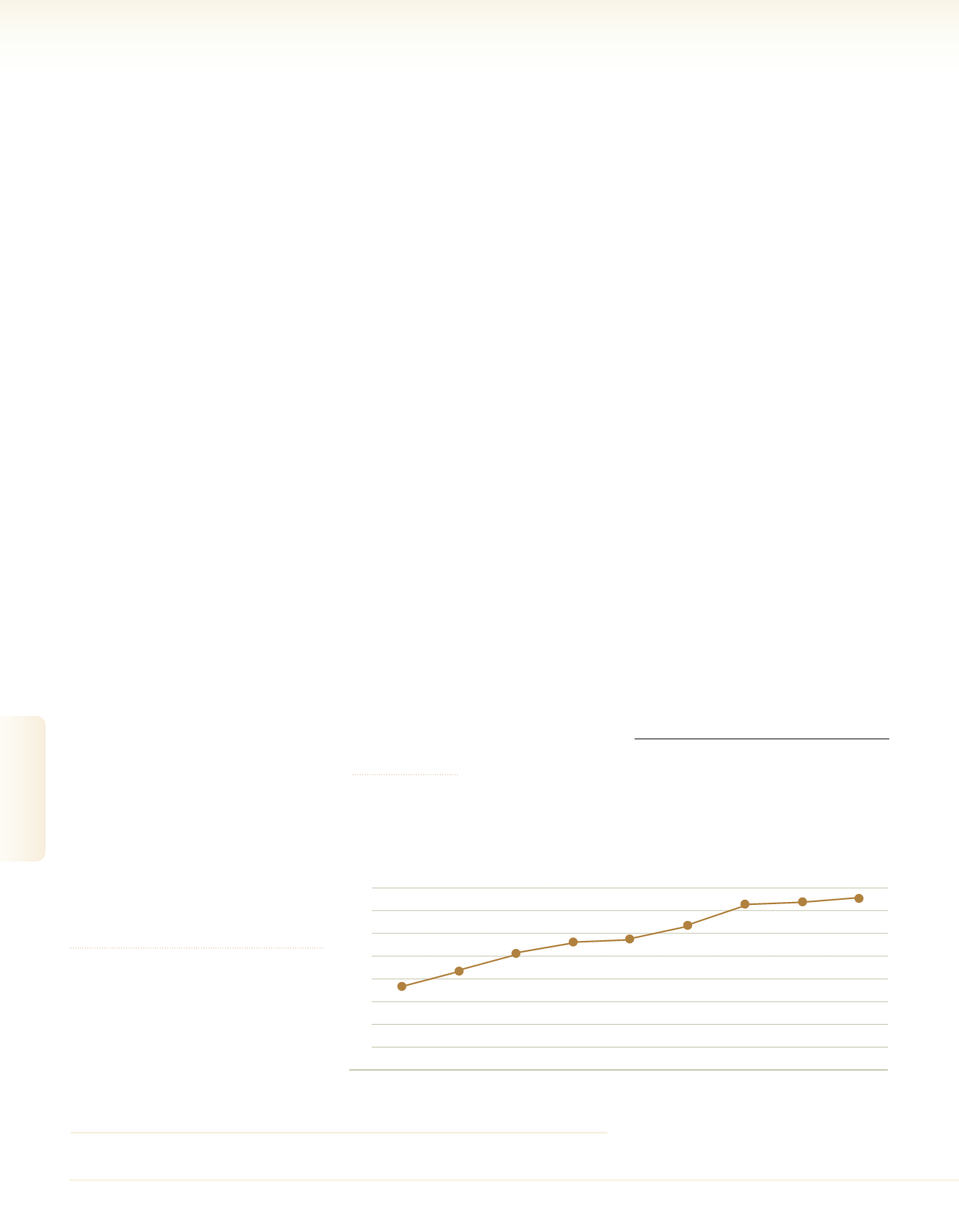

T
he rapid growth in demand against the
restricted supply is expected to con-
tinue and enhance the rise in housing
prices in Israel, in the coming years. The annual
rate of housing price rises sped up in the sum-
mer of 2015 to about 5.6%, compared to the
average 4% at the beginning of the year. Sales
of new apartments in the 12 months that ended
in October 2015 were 35%higher compared with
the previous 12 months and reached more than
30,000 housing units.
1
In this graph it is possible to see the steep in-
crease in housing prices in the past few years,
which characterizes the field of residential real
estate.
The situation of the housingmarket is dependent,
among other things, on the success of various
government plans. The new "Buyers Price Target
Plan" (Mechir Lamishtaken) (a plan that offers
apartments at discounted prices for those en-
titled), significantly expanded the groups entitled
to participate in the plan and those entitled to
participate can now do so without meeting sal-
ary threshold conditions/military service/ family
status, etc. In addition, the new plan does not
restrict the size of apartments, provides a grant
of between NIS 40,000 and 60,000 in outlying
regions, and subsidizes land development, by
more than 40%.
Choosing participants from among those with
entitlement who registered for the project is
conducted through a lottery, carried out by the
Ministry of Construction and Housing. Those in-
terested in registering for the lotterymust submit
an application to theMinistry of Construction and
Housing to receive a certificate of entitlement
via the Mechir Lamishtaken website. Purchas-
ing these apartments is restricted to first time
homebuyers or someone who has not owned a
home in recent years.
Building Starts and Building Finishes in 2015
In 2015, construction began on about 47,750
new homes in Israel's economy, of which about
27%were in buildings with one or two units (de-
tached and semi-detached houses). The number
of homes began during this period was 3.9%
higher compared with the corresponding period
of 2014.
The largest number of homes on which con-
struction was begun in 2015 was recorded in
the Central District and represented about 25%
of overall homes, while in the JerusalemDistrict,
there were only about 10% of total homes.
In 2015, compared with the corresponding period
of 2014, a rise of about 48% was recorded in the
Southern District, about 8% in the Tel Aviv Dis-
trict, about 7% in the Northern District and about
1% in the Jerusalem District. In contrast, over the
same period there was a decline of about 11%
in the Central District and about 8% in the Haifa
District.
About 54% of the homes on which construction
began in the Northern Region were detached or
semi-detached houses, compared with 6% in the
Tel Aviv District.
During the year construction of about 43,400
homes was completed, about 2.8% less than the
corresponding period of 2014. About 30% of the
homes built were in detached or semi-detached
houses.
The largest number of homes completed was in
the Central Region – about 29% of the overall
homes were in that region, while in each of the
Haifa and Jerusalem Regions this figure was only
about 10%.
There was a decline of about 17% recorded in the
Southern District and of about 10% in the Haifa
District compared with the corresponding period
in 2014. In contrast, there was a rise recorded of
about 15% in the number of homes in which con-
struction was completed in the Tel Aviv District.
2
Sheltered Housing
There is a close connection between the scale of
activities in sheltered housing in Israel and the
constant increase in the Israeli population, the
rise in the standard of living, and the rise in life
expectancy of the Israeli population. According to
estimates in this sector, there are about 12,500
sheltered housing unitswithmost of themconcen-
trated in the Tel Aviv Metropolitan and Hasharon
regions. In many of the sheltered housing homes
tenants have a range of services including swim-
ming pools, spas, fitness rooms, extra-curricular
activities, restaurants, clinics, etc.
The companies operating in this sector are faced
with hardships in expanding due to the relatively
low supply of available land in Israel for sheltered
housing complexes, whichmoderates the compe-
tition in the sector and mainly allows expansion
of operations through the purchasing of existing
homes from other companies.
Themostdramaticchangeinthefield,whichmight,
among other things, influence future rankings, is
the entry of the Azrieli Group into the sheltered
housing sector. During 2015, the Group acquired
the Palace sheltered housing home in Tel Aviv,
which is considered one of the most luxurious in
the country. As this article is being written, the
Azrieli Group is working towards acquiring Ahuzat
Bayit, Ra'anana, which will join the two projects
that the Group is developing in the sheltered hous-
ing sector in Modi'in and Lahavim, and which are
planned to be occupied in 2018.
Construction & Real Estate
Average Housing Price Index
385.6
365.9
359.2
400
326.4
350
299.3
289.9
300
262.3
223.0
250
196.2
200
150
100
50
0
Until May
2016
2015
2014
2013
2012
2011
2010
2009
2008
Source: Central Bureau of Statistics
1
The Israeli Housing Market, December 2015 Stan-
dard & Poor's Maalot.
2
Building starts and building finishes, 2015, Central
Bureau of Statistics.
116
2016
|
DUN’S
100
DUN’S
100
|
2016
DUN’S
100
|
2016
2016
|
DUN’S
100
Construction & Real Estate
















